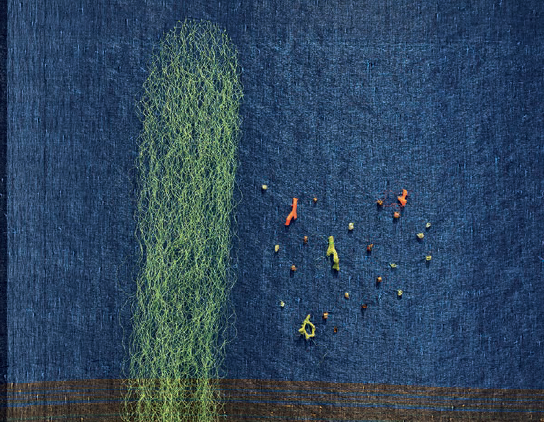Ari Bayuaji
“The Ocean Called Home” is an exhibition of plastic. Rather than asking viewers to see the refuse in the ocean, Montreal-based Indonesian artist Ari Bayuaji asks us to find the ocean in its refuse by weaving seascapes in various degrees of abstraction, using plastic threads pulled from disassembled fishing ropes collected from the beaches and mangrove forests of Bali. Composed of oceanic trash, Bayuaji’s sculpturally inflected textiles represent an organic world through a conspicuously inorganic medium.
Some works confront the viewer more directly with this oil-based material. Salvaged children’s toys dangle at the end of a piece of knitting anchored to a branch in On a Mangrove Tree, 2023. In Coral’s Life, 2023, bits of sculptural coral—cast from plastic—hang from the tapestry in unruly fluorescent tangles.
When Bayuaji began working on “The Ocean Called Home,” he says in a video produced by Pierre-François Ouellette art contemporain, “the most important thing was to give some jobs to the people in the community.” The pandemic devastated Bali’s tourist-dependent economy, and Bayuaji saw an opportunity to support locals while foraying into an Indonesian weaving technique called ikat. Along with his assistants, he extracted the colourful plastic threads at the core of discarded fishing ropes, then tied shorter strands together and wound them into spools around plastic water bottles. Bayuaji’s assistants then fed these knotted threads into a loom, laboriously weaving them into textiles designed by the artist.

Ari Bayuaji, The Light in the Deep Blue, 2023, woven plastic and cotton threads, semi-precious stone, plastic coral, 190 × 104 centimetres. Courtesy Pierre-François Ouellette art contemporain, Montreal.
The vibrant colours at the core of these otherwise dull turquoise ropes are a visual warning—like the skin of a poison dart frog—designed to alert fishermen to the fraying of their nets. After being jettisoned, piles of such colourfully defunct rope wash onto Balinese shores where they get caught in tidal mangrove forests. Bayuaji’s project salvages the ropes, removing them and their attendant harm from the ecosystem, largely silencing the alarm they might be making to sound about their own imperishability. The tapestries from which they’re spun, transported to the other side of the world and installed in a commercial gallery, largely lose their ecocritical valence as they’re converted into reassuringly formalist luxuries.
Just as plastic displaces marine ecosystems, Bayuaji’s conceptual manoeuvre displaces the natural with the artificial, mirroring the ecological damage these works so lightly critique. In The Light in the Deep Blue, 2023, a yellow beard of plastic thread, evoking a tangle of uprooted seaweed, floats atop a tapestry sectioned into woven colour fields. A smattering of plastic coral sculptures and semi-precious stones is sewn beside it. Though critical engagement is either implicit or illegible in such tapestries, a protest is expressed in the exhibition’s largest sculpture, The Rangda, 2022, depicting the incarnation of Calon Arang, a legendary witch who wreaked havoc on ancient Java by destroying crops and spreading plagues. In Bayuaji’s rendition, the wide-eyed witch is cloaked in heaps of plastic thread, personifying the destructive agency of our techno-fossil detritus.
However, the conceptual coherence between the malignance of Calon Arang and the serenely apolitical surface of works like The Light on the Sky above the Sea, 2023— in which glass beads glitter atop an ocean of orange, green and purple light—is not always clearly evident. Lacking conceptual mediation in the artworks themselves, the delicacy and care of Bayuaji’s process remain in tension with the brute physicality of the ecological disaster in which the materials are implicated.

Ari Bayuaji, The Light in the Deep Blue (detail),
That said, Bayuaji’s aesthetics of salvage, recycling and ecological care find redemption through curatorial support at Pierre-François Ouellette art contemporain. A foot of unprocessed fishing rope sits on a bench in the gallery, alongside a spool of plastic thread. In a small room connected to the gallery space, a video documents the artist’s process. We see Bayuaji wandering on an Indonesian beach, picking up a rag of plastic fishing net tangling bits of bleached coral. He admires the sparkling sediment of a volcanic beach, pries the shells off the hull of an upturned boat, returns a clump of seaweed to the water. The beauty of Bayuaji’s project lies in its attention to such mundane objects—ropes, glass beads, a metal pan—and the acts of collection and processing undertaken by the artist and his assistants.
Bayuaji’s “Weaving the Ocean” project is perhaps most compelling as an act of what he calls “community empowerment.” Through the artist’s ingenuity and resourcefulness, he provided employment to a community reeling from the precarity of a pandemic economy. Yet Bayuaji’s admirable effort to turn his practice into a form of small-scale social security, though avoiding the snares of self-interest, nonetheless affirms commodification as an artistic good in itself, celebrating the miracle of value creation, whereby capital conjured from “upcycled” jetsam trickles down from artist to assistants. (Bayuaji emphasizes this economic utility by extolling the scalability of “Weaving the Ocean” in the video documenting its creation.)

Ari Bayuaji, installation view, “The Ocean Called Home,” 2023, Pierre- François Ouellette art contemporain, Left to right: The Full Moon, 2022, 81.3 × 88.9 × 3 centimetres; The Light in the Deep Blue, 2023, 190 × 104 centimetres; The Light on the Sky above the Sea, 2023, 183 × 110 centimetres.
The supplementary material we are given in order to understand Bayuaji’s practice is thoughtful, yet difficult to reconcile with the placid formalism of the tapestries and their ready-made appendages. Ultimately, by insufficiently accounting for the implications of the conceptually seductive conversion of oceanic trash into weavable threads, “The Ocean Called Home” ends up reading like a frankly commercial endeavour. In the face of the ecological harm of industrial fishing, we are offered a quaint entreaty to recycle and buy. ❚
“Ari Bayuaji: The Ocean Called Home” was exhibited at Pierre-François Ouellette art contemporain, Montreal, from May 27, 2023, to August 5, 2023.
Hannibal de Pencier is a writer and independent researcher based in London, England.

